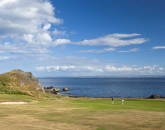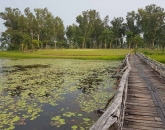 Deane Beman was sitting on the patio behind the 18th green at Dalat Palace Golf Club two Decembers ago when the three-and-a-half-hour round he’d just completed produced a realization.
Deane Beman was sitting on the patio behind the 18th green at Dalat Palace Golf Club two Decembers ago when the three-and-a-half-hour round he’d just completed produced a realization.
“I’m not sure there’s a prettier setting for golf than Dalat,” said the former playing professional who also served as Commissioner of the PGA Tour in America for 25 years. “The greens are as good as I’ve ever putted. They’re as good as you’re ever going to find. They sit well, like greens of the classic courses.”
Truth is, Dalat Palace, in the cool Central Highlands of Vietnam, is as classic as golf courses come. One need only look at its history, which begins in 1922. That’s when the renowned French architect, Ernest Hebrard, laid out the master urban plan for the still fledgling hill station resort in Dalat.
Although 1922 is often reckoned as the year the Dalat course opened, this is not likely. Nor is it likely that the course was the inspiration of Bao Dai, the last emperor of feudal Vietnam. Bao Dai was born in 1913 and spent much of his youth in France. He did not return to Vietnam until 1932, at which time the golf course in Dalat was probably open for play. It’s not yet certain exactly when the first hickory stick swiped at a gutta percha ball on the first tee at Dalat, but 1931 is a very good bet.
Around 1930, the renowned golf course architectural firm, Colt & Alison, listed the “Ville de Dalat” in “Indo China” as one of the courses in their worldwide portfolio. The course had not been listed in their promotional material throughout the 1920s, according to researcher Paul Turner. Nor was the course allotted a categorization in the c. 1930 advertisement, which suggests the course was in the preliminary stages of development at that time.
Turner’s research has not turned up any evidence that Harry S. Colt (1869-1951) or Charles H. Alison (1882-1952) had traveled to Vietnam to plot the course, and he thinks it’s unlikely that either architect had. “C.H. Alison did work in Japan in 1930,” wrote Turner [see HK Golfer July/August 2008 edition]. “Occasionally Colt would design a course from [topographic] maps or aerial photography. He was reported to have done so for a course (Bukit Timah Club) in Singapore.” Turner believes Colt & Alison may have routed the Dalat course the same way.
Pages
Click here to see the published article.











